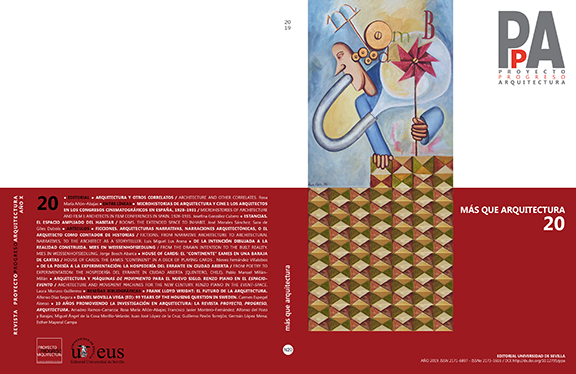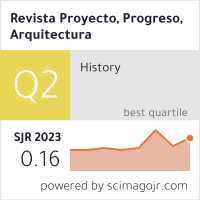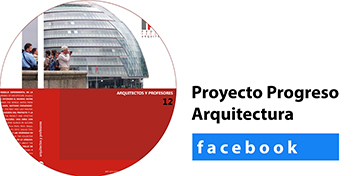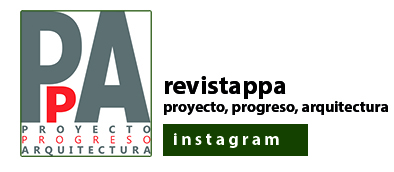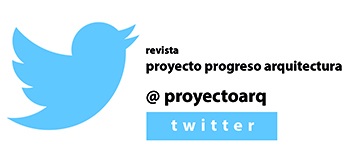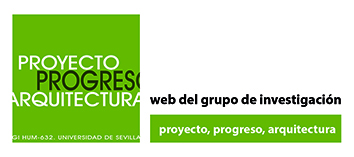FICCIONES. DE LA ARQUITECTURA NARRATIVA Y LAS NARRACIONES ARQUITECTÓNICAS AL ARQUITECTO COMO CONTADOR DE HISTORIAS / FICTIONS. FROM NARRATIVE ARCHITECTURE TO ARCHITECTURAL NARRATIVES, TO THE ARCHITECT AS A STORYTELLER
DOI:
https://doi.org/10.12795/ppa.2019.i20.03Palavras-chave:
literatura, especulación, fabulación, utopía, ciencia ficción / Literature, Speculation, Fabulation, Utopia, Science FictionResumo
RESUMEN Las ficciones, entendidas en un sentido amplio, forman parte del quehacer habitual del arquitecto. Desde la definición del programa al proceso de proyecto, los arquitectos requerimos de narrativas que guíen nuestra toma de decisiones. La ficción, en sentido estricto, ha estado presente también en diferentes formas a lo largo de la historia de la arquitectura, proporcionando ideas alternativas u ofreciendo entornos propicios para la especulación, la generación de discursos y de críticas. “Ficciones…” propone un sucinto recorrido por los modos en que la ficción ha interactuado históricamente con la disciplina como punto de partida para analizar el trabajo de una nueva generación de arquitectos que, en un momento de particular difusión de límites entre aquella y su periferia, la utilizan de maneras diversas. La primera parte analiza el tradicional uso de la ficción como catalizador de procesos de proyecto ejemplificado en el trabajo de la firma estadounidense Design With Company. A partir de este, el texto pasa a examinar el fenómeno que, agrupado en torno al debate sobre la arquitectura-ficción, ve cómo profesionales de la arquitectura encuentran en la producción de ficción arquitectónica un campo alternativo de ejercicio profesional.
SUMMARY Fictions, taken in a broad sense, are part of the architect’s daily practice. From the definition of the program to the design process, architects need narratives to guide their decision making. Fiction, in the strict sense, has also been present in different forms throughout the history of architecture, providing alternative ideas or offering favorable environments for speculation, and for the generation of discourses and criticism. “Fictions…” offers a quick overview of the ways in which fiction has interacted historically with the discipline as a starting point to analyze the work of a new generation of architects who, working at a time of blurring of boundaries between architecture and its periphery, use it in different ways. The first part analyzes the traditional use of fiction as a trigger for design processes, using the work of the American office Design With Company as a case study. Secondly, the text examines the phenomenon which, emerging from the discussion on architecture-fiction, finds architects gravitating towards the production of architectural fictions as an alternative field to practice the profession.
Downloads
##plugins.generic.paperbuzz.metrics##
Referências
ABRAHAM, Carlos. Borges y la ciencia ficción. Granada: AJEC, 2010: 40.
BALLARD, James Graham. A Handful of Dust. En: The Guardian [en línea]. Lunes, 20 de marzo de 2006 [consulta: 1 octubre 2018]. Disponible en: https://www.theguardian.com/artanddesign/2006/mar/20/architecture.communities
BANHAM, P. Reyner. Space, Fiction, and Architecture. En: The Architects’ Journal. Londres: The Architectural Press, 17 abril 1958, vol. 127, pp. 557-559.
BANHAM, P. Reyner. The Glass Paradise. En: Architectural Review. Londres: The Architectural Press, febrero 1959, n.º 125, pp. 87-89.
BETSKY, Aaron. The Alpha and the Omega. En: Beyond. Scenarios and Speculations. Róterdam: Sun Publishers, 2009, n.º 1, p. 125.
BORGES, Jorge Luis. Films. En: Jorge Luis BORGES. Discusión. Buenos Aires: M. Gleizer, Colección de Nuevos Escritores Argentinos, 1932. Publicación reciente en: BORGES, Jorge Luis. Discusión. Obras completas, vol. 1. Buenos Aires: Emecé, 2002, pp. 254-259.
BORGES, Jorge Luis. Análisis de la obra de Herbert Quain. En: Jorge Luis BORGES. El jardín de senderos que se bifurcan. Buenos Aires: Sur, 1941.
BORGES, Jorge Luis. Avatares de la tortuga. En: Jorge Luis BORGES. Discusión. Obras completas, vol. 1. Buenos Aires: Emecé, 2002, pp. 254-259.
COLLINS, George R. Visionary drawings of architecture and planning, 20th century through the 1960s. Cambridge, Mass.: MIT Press, 1979.
DERY, David. Architecture Fiction: Premonitions of the Here and Now. En: Thought Catalog [en línea], 9 de febrero de 2011 [consulta: 1 octubre 2018]. Disponible en: https://thoughtcatalog.com/mark-dery/2011/02/architecture-fiction-premonitions-of-the-present/#iv
DESMAZIÈRES, Erik. Onze estampes inspirées de la nouvelle de Jorge-Luis Borges “La biblioteca de Babel”. París: Aux dépens de l'artiste/Atelier René Tazé, 1998.
DE WOLFE, Ivor; BROWNE, Kenneth. Civilia: the end of sub urban man: a challenge to Semidetsia. Londres: Architectural Press, 1971.
GISSEN, David. Architecture Fiction - A short review of a young concept. En: HTC Experiments [en línea], 22 de febrero de 2009 [consulta: 1 octubre 2018]. Disponible en: https://htcexperiments.org/2009/02/22/architecture-fiction-%E2%80%94-a-short-review-of-a-young-concept
GRAU, Cristina. Borges y la arquitectura. Madrid: Cátedra, Ensayos Arte, 1989.
HICKS, Stewart; NEWMEYER, Allison. Tales from the Fabulous Middle. Conferencia en MAS Context: Analog. Chicago: New Projects Gallery, 15 de octubre de 2011. En: mascontext.com [en línea], [consulta: 1 octubre 2018]. Disponible en: http://www.mascontext.com/events/mas-context-analog-2/mas-context-analog-stewart-hicks-allison-newmeyer
HICKS, Stewart; NEWMEYER, Allison. Chicago P.L.O.T.s - A Land Institute Addendum. En: PLAT Journal. If you see something, say something. Houston, Tex.: Rice School of Architecture, primavera /verano 2012, n.º 2.0.
HICKS, Stewart; NEWMEYER, Allison. Chicago Institute of Land Generation. En: Bracket. Goes Soft. Barcelona, Nueva York: Actar, 2012, n.º 2, pp.159-167.
HICKS, Stewart; NEWMEYER, Allison. Late Entry to the Chicago Public Library Competition. En: MAS Context. BOLD, primavera 2016. Chicago: MAS Studio, n.º 29, pp. 144-55.
HICKS, Stewart. Conferencia en el evento “Envisioning New SpatialOrganizations”, Chicago: Chicago Design Museum, 14 de febrero de 2018. En: mascontext.com [en línea], [consulta: 1 octubre 2018]. Disponible en: http://www.mascontext.com/events/mas-context-spring-talks-2018/envisioning-new-spatial-organizations/
LAI, Jimenez. Citizens of No Place: An Architectural Graphic Novel. Nueva York: Princeton Architectural Press, 2012.
LIM, C. J.; LIU, Ed. Short Stories: London in Two-and-a-Half Dimensions. Abingdon, Oxon; Nueva York: Routledge, 2011.
LUS ARANA, Luis Miguel. Comics and Architecture: A reading guide. En: Jonathan CHARLEY, ed. The Routledge Companion on Architecture, Literature and the City. Londres; Nueva York: 2019, pp. 347-384.
MOHOLY-NAGY, László. Von Material Zu Architektur. Múnich: A. Langenverlag, Bauhausbücher, n.º 14, 1929.
MORTICE, Zach. Next Progressives: Design with Company. En: Architect Magazine [en línea]. Washington, D. C.: Hanley Wood, 15 septiembre 2015. [consulta: 1 octubre 2018]. Disponible en: https://www.architectmagazine.com/next-progressives/
POLI, Matteo. Farmland World. Design With Company. En: Abitare, abril 2012, n.º 521, p. 72.
RIBART DE CHAMOUST, Charles François. L’elephant triomphal, grand kiosque a la gloire du roi. París: L’Imprimerie de Moreau (texto), Pierre Patte (láminas), 1758.
SAUNDERS, William S. Rem Koolhaas’s Writing on Cities: Poetic Perception and Gnomic Fantasy. En: Journal of Architectural Education, septiembre 1997, Vol. 51(1), pp. 61-71.
SCHUMACHER, Patrick. Schumacher slams British architectural education. En: The Architectural Review [en línea], 31 enero 2012 [consulta: 15 marzo 2019]. Disponible en:
SCHOLES, Robert. Structural Fabulation; An Essay on Fiction of the Future. Notre Dame, Ind.: University of Notre Dame Press, 1975.
SOBCHACK, Vivian. Screening Space. The American Science Fiction Film. Segunda edición ampliada. Nueva York: Ungar, 1997.
SOLOMONSON, Katherine. The Chicago Tribune Tower Competition: Skyscraper Design and Cultural Change in the 1920s. Urbana: University of Chicago, 2003.
STERLING, Bruce. Slipstream. En: Science Fiction Eye. Beyond Cyberpunk. Til Washington, D. C.: ’Til You Go Blind Cooperative, julio de 1989, vol. 1, n.º 5, s/p.
STERLING, Bruce. The Growthing. Metropolis Magazine [en línea], 1 de enero de 2003 [consulta: 15 marzo 2019]. Disponible en: https://www.metropolismag.com/ideas/arts-culture/the-growthing/.
STERLING, Bruce. Science Fiction and Architecture Fiction. En: Off Center [en línea], 20 de marzo de 2006 [inaccesible].
TIGERMAN, Stanley; COHEN, Stuart E. Late entries to the Chicago Tribune Tower competition. Nueva York: Rizzoli, 1980.
VAN DER HOORN, Mélanie. Bricks & balloons: architecture in comic-strip form. Róterdam: 010 Publishers, 2012.
VAN DER HOORN, Mélanie. More architecture per cubic meter. On the potential contribution of the comic strip medium to architecture projects. En: Olof van de WAL (ed.): Architecture Bulletin. Róterdam: NAi010 Publishers, 2007, n.º 3, pp. 51-6.
VARNELIS, Kazys. In defense of architecture (fiction). En: Varnelis.net [en línea], 2 de marzo de 2009 [consulta: 1 octubre 2018]. Disponible en: http://index.varnelis.net/blog/in_defense_of_architecture_fiction
WHYTE, Iain Boyd. Introduction. En: Iain BOYD WHYTE, ed. y trad. The Crystal Chain Letters: Architectural Fantasies by Bruno Taut and His Circle. Cambridge, Massachusetts: The MIT Press, 1985.
WILTON-ELY, John. Introduction. En: Giambattista PIRANESI. Observations on the letter of Monsieur Mariette: with opinions on architecture, and a preface to a new treatise on the introduction and progress of the fine arts in Europe in ancient times.Trad. Caroline Beamish y David Britt. Los Ángeles, CA: Getty Research Institute, col. Texts & Documents, 2002, pp. 1-86.
Publicado
Como Citar
Edição
Seção
Licença
Las ediciones impresa y electrónica de esta Revista son editadas por el Secretariado de Publicaciones de la Universidad de Sevilla, siendo necesario citar la procedencia en cualquier reproducción parcial o total.
Salvo indicación contraria, todos los contenidos de la edición electrónica se distribuyen bajo una licencia de uso y distribución “Creative Commons Atribución-NoComercial-SinDerivar 4.0 Internacional” ![]() . Puede consultar desde aquí la versión informativa y el texto legal de la licencia. Esta circunstancia ha de hacerse constar expresamente de esta forma cuando sea necesario.
. Puede consultar desde aquí la versión informativa y el texto legal de la licencia. Esta circunstancia ha de hacerse constar expresamente de esta forma cuando sea necesario.
Los autores/as que publiquen en esta revista aceptan las siguientes condiciones:
- Los autores/as conservan los derechos de autor y ceden a la revista el derecho de la primera publicación, con el trabajo registrado con la licencia de atribución de Creative Commons, que permite a terceros utilizar lo publicado siempre que mencionen la autoría del trabajo y a la primera publicación en esta revista.
- Los autores/as pueden realizar otros acuerdos contractuales independientes y adicionales para la distribución no exclusiva de la versión del artículo publicado en esta revista (p. ej., incluirlo en un repositorio institucional o publicarlo en un libro) siempre que indiquen claramente que el trabajo se publicó por primera vez en esta revista.
- Se permite y recomienda a los autores/as a publicar su trabajo en Internet (por ejemplo en páginas institucionales o personales) antes y durante el proceso de revisión y publicación, ya que puede conducir a intercambios productivos y a una mayor y más rápida difusión del trabajo publicado (vea The Effect of Open Access).
- Resumo 1048
- ARTÍCULO (CASTELLANO-INGLÉS) (Español (España)) 393
